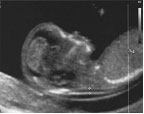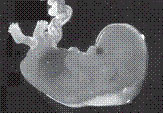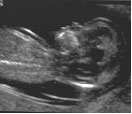Down Syndrome - Prenatal Screening and Diagnosis (Part Two)
 |
 |
 |
 |
| Figure 1. Normal NT | Figure 2. Abnormal accumulation of fluid at the back of the neck of a Down fetus in the 12th week of intrauterine life. | Figure 3. The same case as Figure 2, seen in ultrasound. Clearly shows increased NT. | Figure 4. Child with DS. |
* Free β-hCG. Maternal plasma concentrations of free β-hCG are higher in fetuses with DS compared to normal fetuses.
* PAPP-A (pregnancy-associated plasma protein A). Levels of PAPP-A are lower in pregnancies with Down fetuses compared to pregnancies with normal fetuses.
* Bi-test. When maternal age is combined with the biochemical screening of the first trimester (free βhCG and PAPP-A), the screening capability for DS reaches 60% with a false-positivity rate of 5%.
* Combined screening in the first trimester (Ultrascreening). NT and the biochemical markers of the bi-test are independent parameters from each other. This justifies their combination (together with the base risk) in calculating the final risk for DS.
The final risk is nothing but the product resulting from the multiplication of 4 risks (factors) arising from maternal age, pregnancy age at the time of examination, NT, and the bi-test. This combination, called the first trimester combined screening (or ultrascreening), has a screening capability for DS of 90-95%, with a false-positivity rate of 5%. Patients with a positive result (high final risk) are advised to undergo invasive diagnosis.
Second phase is screening in the second trimester through the triple-test from week 15 to week 18 of pregnancy. This test assumes dosing in maternal blood of alpha-fetoprotein (AFP), free β-hCG, and urinary estriol EU. Pregnancies that have a Down fetus, have plasma levels higher than the norm of AFP, higher than norm of free β-hCG, and lower than norm of EU.
By combining the risks arising from each of the three markers together with the base risk, a screening capability for Down fetuses of 60% for women under 35 years old (false positivity of 5%) and 75% for women over 35 years old (higher false-positivity). The triple test is a good alternative for pregnant women who did not benefit from biochemical screening (bi-test) in the first trimester. Women who test positive after the triple-test are offered invasive diagnosis (amniocentesis).
Integrated test includes combining the results of ultrascreening with those of the triple-test. Although with a higher screening capability for DS, this test is difficult to apply to a population since it is not compliant (not all women can wait from the first trimester to the middle of the second trimester to calculate the risk for DS.
Third phase: Morphological Ultrasound in the second trimester (week 18-22) is a standard that is also offered in Albania. Unfortunately, a portion of pregnant women are more compliant with determining the sex through ultrasound than with morphological ultrasound. Besides screening for DS, it can also diagnose other fetal malformations.
Among the ultrasound signs (parameters) suggestive for DS include: anomalies of the central nervous system (ventriculomegaly, holoprosencephaly, microcephaly, choroid plexus cysts, agenesis of the corpus callosum, enlarged cisterna magna, etc), facial defects (labio and palatoschisis), macroglossia, increased nuchal fold, cystic hygroma, small ears, microphthalmia, nasal agenesis or hypoplasia, cardiac anomalies (intracardiac echogenic foci, pericardial effusions), pleural effusions, two-vessel umbilical cord, umbilical cord cysts, Swiss cheese pattern placenta, gastrointestinal anomalies (duodenal atresia, esophageal atresia, tracheoesophageal fistula, omphalocele, diaphragmatic hernia, hyper-echogenic loops), genitourinary anomalies (cystic renal dysplasia, hydronephrosis, ambiguous genital organs), skeletal anomalies (short femur, "sandal gap" foot sign, short clavicle), early intrauterine developmental delay, etc.
Emancipation issue?
The detection of fetal malformations is inevitably linked to the level of society's emancipation. Unfortunately, a part of the couples in our country spend time and money doing out-of-schedule ultrasounds just to see the sex of the baby, overlooking the optimal moments in which the detection of fetal malformations is very sensitive.
Material on fetal malformations, very informative about detection methods, I ask where we can do a test for a one-month-old baby regarding the confirmation or non-confirmation of DS (Down Syndrome).
During the prenatal period, all screening tests were done except for amniocentesis and everything was normal (the pregnant woman was under 35 years old). I have a suspicion about this DS now in a one-month-old baby of a relative of mine.
Can DS be determined in a one-month-old baby only with karyotype? With respect to you, dear
Sent by Nurishahe, më 04 November 2013 në 12:20
A simple karyotype in the baby would confirm or rule out DS (Down Syndrome)
Sent by Elton Peci, më 05 November 2013 në 13:56
Thank you very much Dr. Elton,
Your article is very informative and educational, I congratulate you on your very professional and scientific work,
all the best
Sent by Nurishahe, më 06 November 2013 në 02:45
I was born in January, a girl just as I entered the 9th month of normal birth. The girl did not cry and lived for 8 hours before she passed away. The doctor told me that the stomach and intestines had moved up to the chest area and the heart did not start to work properly, so the baby did not survive. I felt bad because I had a normal pregnancy and at the last moment, they told me that the child had problems. How do you explain my situation, what is the cause of this anomaly in my baby? With respect, Matilda
Sent by Matilda, më 21 Agust 2014 në 06:42
Dear, okay very good that Down syndrome can be diagnosed earlier, but do you know how many other diagnoses exist that are unknown through any analysis, and would mothers kill their own fetus just because it has Down syndrome?!
Sent by Leonora , më 25 September 2015 në 13:13